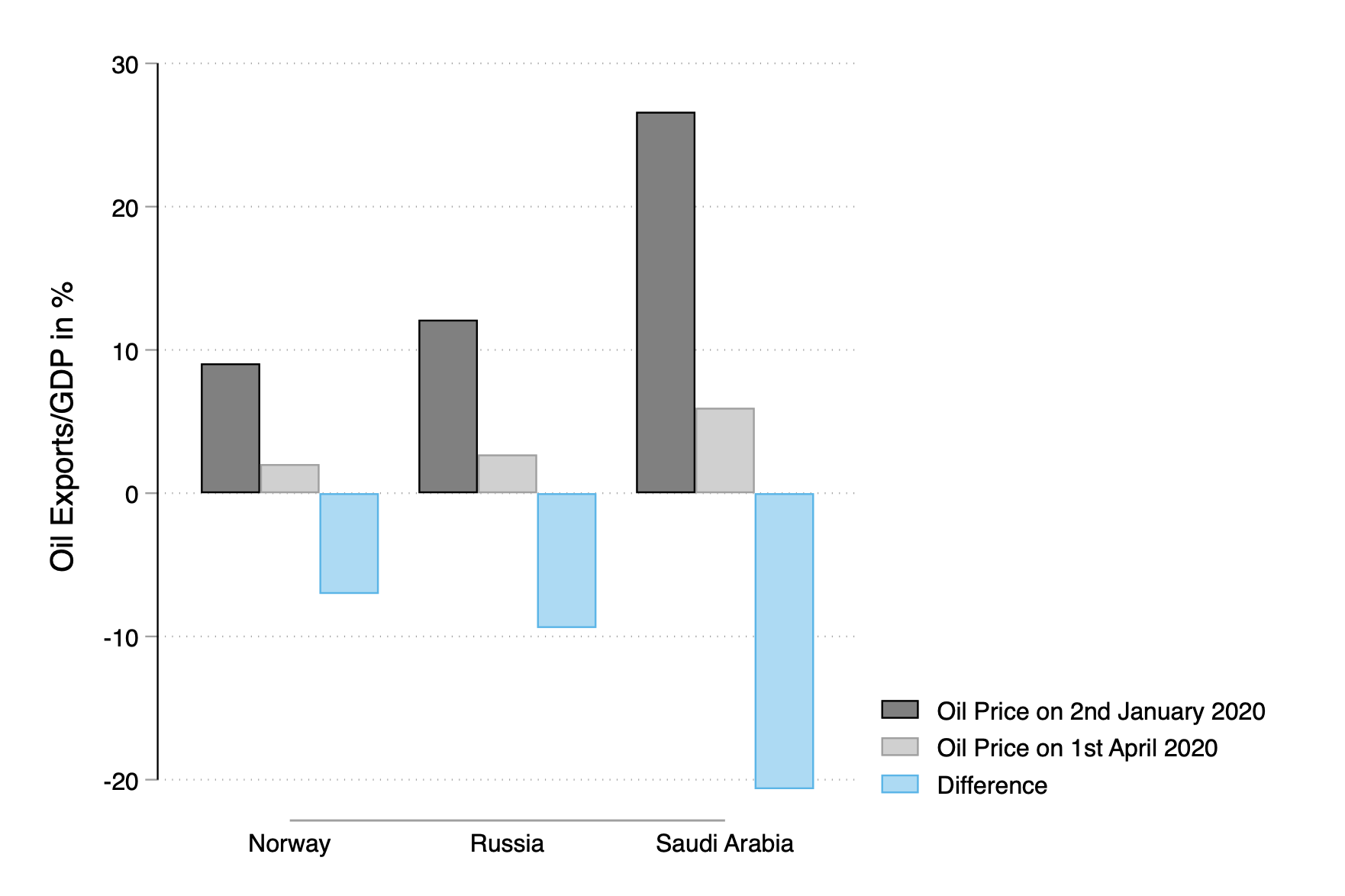Oil-exporting countries suddenly seem a lot poorer than they were just a few months ago. The cratering of oil demand, due to anti-COVID-19 measures, and the ongoing oil price war jointly led – for the first time in history – to a negative oil price in the US on 20 April 2020. Between January and early April 2020, the Brent international oil price benchmark had fallen from $70 to approximately $20 per barrel (see Figure 1). The oil revenues of firms and governments in oil-exporting economies have thus plummeted together with the real income of the citizens of these economies. In Figure 2, we show how the drop in the price of oil between January and April 2020 affects the value of exports of three large oil exporters.
Figure 1 Real price of a barrel of Brent crude oil in April 2020, $
Resource rich economies are now facing a dual shock (Arezki and Nguyen 2020). They are exposed to the economic consequences (Baldwin and Weder di Mauro 2020a) of the global pandemic in ways which are unrelated to their resource wealth and may call for swift policy measures (Baldwin and Weder di Mauro 2020b). They also suffer from a negative terms of trade shock, resulting in lower government revenues and less financial capacity to deal with the current events. Since oil rich developing economies are often classified as economically and politically fragile (Ross 2013), there is reason for concern that the current situation may lead to an erosion of economic and social stability (Arezki and Fan 2020) if the drop in the oil price persists (Economist 2020).
The silver lining of the current situation is the potential of lower foreign oil revenues to benefit producers of tradable – predominantly manufacturing – goods in oil exporting countries. Lower inflows of foreign revenues trigger lower demand for local non-tradable goods. This frees-up labor and capital, which reallocates to other sectors. A drop in the oil price is thus a sign of good-times-to-come in the tradable goods sector. Since this sector is often associated with positive externalities – such as learning-by-doing or other productivity spillovers – the growth of this sector may be beneficial to exporters over the longer term. However, in order for countries to manage such a structural transformation of the economy successfully, policy makers may require guidance in quantifying the magnitudes and the speed with which workers and capital may reallocate to other activities.
Figure 2 Country level oil exports as a fraction of GDP
Note: Exports are calculated by multiplying the difference between production and consumption with the monthly oil price. Data on production and consumption is for 2018, the last year available in the recent BP Statistical Review. Data on 2018 nominal GDP is taken from the World Bank.
In a recent paper, we identify and quantify changes in the relative price of tradable and non-tradable goods as well as the reallocation of labor across sectors following giant oil and gas discoveries (Harding et al. 2020). The mechanism driving the rise of the tradable sector is the mirror image of the so-called Dutch Disease.1 The term has become standard economic jargon to describe the main theory on the macroeconomic consequences of large resource discoveries and resource price changes (Corden and Neary 1982).
Dutch disease theory
The theory begins with the idea that people care about consuming tradable goods (such as cars) and non-tradable goods (such as haircuts). Higher inflows of foreign revenues from new oil discoveries, or increased oil prices, make consumers richer and hence increase their demand for all goods. Higher demand for tradable goods can be satiated through higher imports, but, in order to satisfy their demand for non-tradable goods, countries need to produce more non-tradable goods. In times of falling oil prices, exactly the opposite will be true. The non-resource export and import-competing sectors will expand (Kuralbayeva and Stefanski 2012, Harding and Venables 2016).
At the core of the model is the so-called real exchange rate (RER): the price of a representative basket of a country’s goods relative to the price of the same basket in a foreign country. Importantly, each basket consists of both tradable and non-tradable goods. Since countries buy tradable goods on a common, international market – the price of tradable goods is the same everywhere. Since non-tradable goods have to be produced locally, their prices can vary across countries based on local conditions. Rising prices of non-tradable goods lead labor and capital to reallocate to the now more lucrative domestic non-tradable goods sector. Prices give researchers and policymakers a window into the changing structure of the economy, as prices respond quickly and price data become available quickly.
Dutch disease evidence
There is abundant anecdotal evidence on the relationship between the price of non-tradable goods and resource wealth. For instance, Luanda, the capital of oil-rich Angola, used to be one of the most expensive African cities. Oslo, the capital of oil-rich Norway, has attracted large numbers of Swedes to cross the border and work in Oslo’s restaurants and bars. Despite such anecdotes and the near canonical status of the theory, it has proven difficult to provide robust empirical evidence for the Dutch disease.
Pinning down the effect of resource wealth on RER is tricky because many other factors may relate to resource wealth while also affecting the real exchange rate. For instance, consider a rapidly developing country that experiences improvements in its political institutions. On the one hand, economic growth is often associated with an increase in the price of non-tradable goods – resulting in a rising RER.2 At the same time, oil companies will be more likely to invest in such a country since they may be less afraid of expropriation. If the entrance of multinational companies in the extractive sector translates into new oil discoveries, we may attribute too much of the appreciation in the real exchange rate to increasing resource wealth.
In our paper, we bring together two components which allow us to disentangle the effects of resource discoveries on prices and factor reallocations. First, we construct a large data set of bilateral real exchange rates – between every country-pair, rather than between each country and the average of its trading partners. This allows us to account for many confounding factors, which would otherwise taint our estimates. Second, we exploit the timing of unexpected giant oil or gas discoveries as a proxy for large changes in resource wealth. The exact timing of a giant discovery is in practice impossible to predict. It can be treated as exogenous, since it is difficult to think of other forces that have an effect on the real exchange rate and vary systematically with the timing of a giant discovery. Even oil companies that are involved in the exploration process do not know when exactly they will make a find: only 2% of all exploration wells lead to a giant discovery.
We find that a large discovery, with a value of 10% of GDP, appreciates the real exchange rate by 1.5% within 10 years following the discovery. The appreciation is gradual, but starts soon after a discovery is made. We confirm that the appreciation is driven by the prices of non-tradable goods, while the prices of tradable goods seem to be anchored by international markets. Our results also confirm the contraction of the manufacturing sector for a subset of OECD countries: the employment share in the traded sector decreases by half a percentage point within 10 years following the discovery.
Dutch disease policy
If economies behave symmetrically in booms and busts, our results might give an indication as to the expected response to the current oil price shock. An oil rich economy that loses 10% of its GDP due to the drop in oil revenue, such as Russia so far in 2020 (see Figure 2), may experience a drop in the price of non-tradable goods by 1.5% and an associated increase in tradable (or manufacturing) sector employment of 0.5 percentage points.
Our results show that the full response can take over 10 years, which is consistent with the fact that revenues from a giant discovery are uncertain and only accrue after production has started. In contrast, the drop in oil revenues driven by a collapse in the oil price is instantaneous. The real exchange rate is then likely to respond fast. Transition of labor and capital across sectors and locations naturally take more time. The speed and magnitude of the changes in prices, labor and capital will also depend on how long-lasting the price drop is perceived to be. The potential structural shifts unleashed by this crisis could give rise to increased growth in the years to come. While the economic forces discussed above will naturally drive this change, policy makers may want to consider policies that will smooth rather than halt this transition. In many countries, there will be frictions to relocating capital and labor across sectors and locations.
References
Arezki, R and R Y Fan (2020), “Oil price wars in a time of COVID-19”, voxEU.org, 10 March.
Arezki, R and H Nguyen (2020), “Coping with a dual shock: COVID-19 and oil prices”, voxEU.org, 1 April.
Baldwin, R and B Weder di Mauro (2020a), Mitigating the COVID Economic Crisis: Act Fast and Do Whatever It Takes, VoxEU.org E-Book, CEPR Press.
Baldwin, R and B Weder di Mauro (2020b), Economics in the time of COVID-19, VoxEU.org E-Book, CEPR Press.
Corden, W M and J P Neary (1982), "Booming sector and de-industrialisation in a small open economy", The Economic Journal 92(368): 825-848.
The Economist (2020), “The collapse: An unprecedented plunge in oil demand will turn the industry upside down”, Briefing, 8 April.
Harding, T, R Stefanski and G Toews (2020), “Boom goes the price: Giant resource discoveries and real exchange rate appreciation”, The Economic Journal, forthcoming.
Harding, T and A Venables (2016), “The Implications of Natural Resource Exports for Nonresource Trade”, IMF Economic Review 64:268–302.
Kuralbayeva, K and R Stefanski (2013), “Windfalls, Structural Transformation and Specialization”, Journal of International Economics 90:273–301.
Ross, M L (2013), The oil curse: How petroleum wealth shapes the development of nations, Princeton: Princeton University Press.
Endnotes
1 The Economist first used the term ‘Dutch disease’ to describe the decline in employment of manufacturing in the Netherlands in the wake of large natural gas discoveries in the 1970s.
2 A process known as the Balassa-Samuelson effect.







